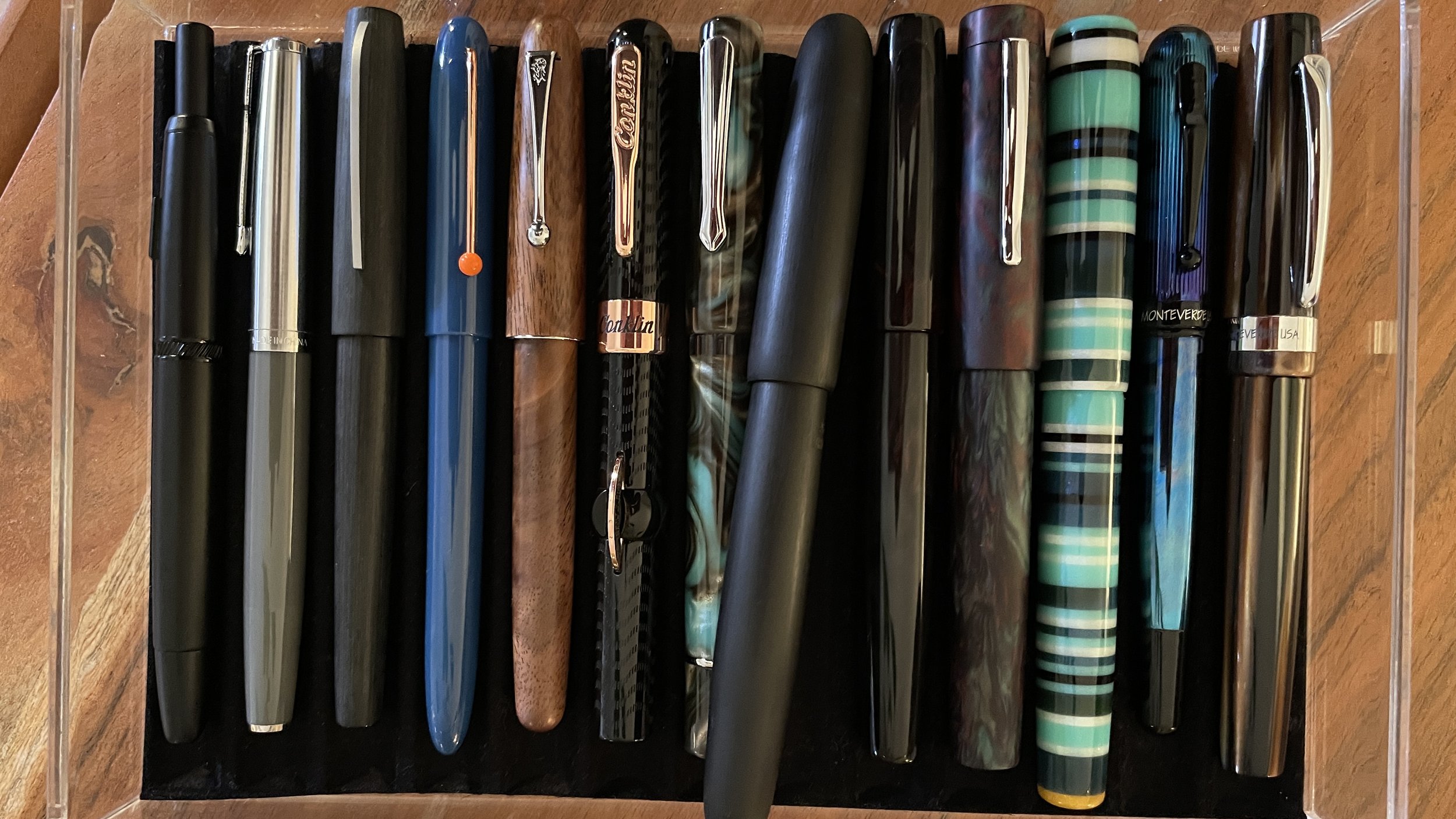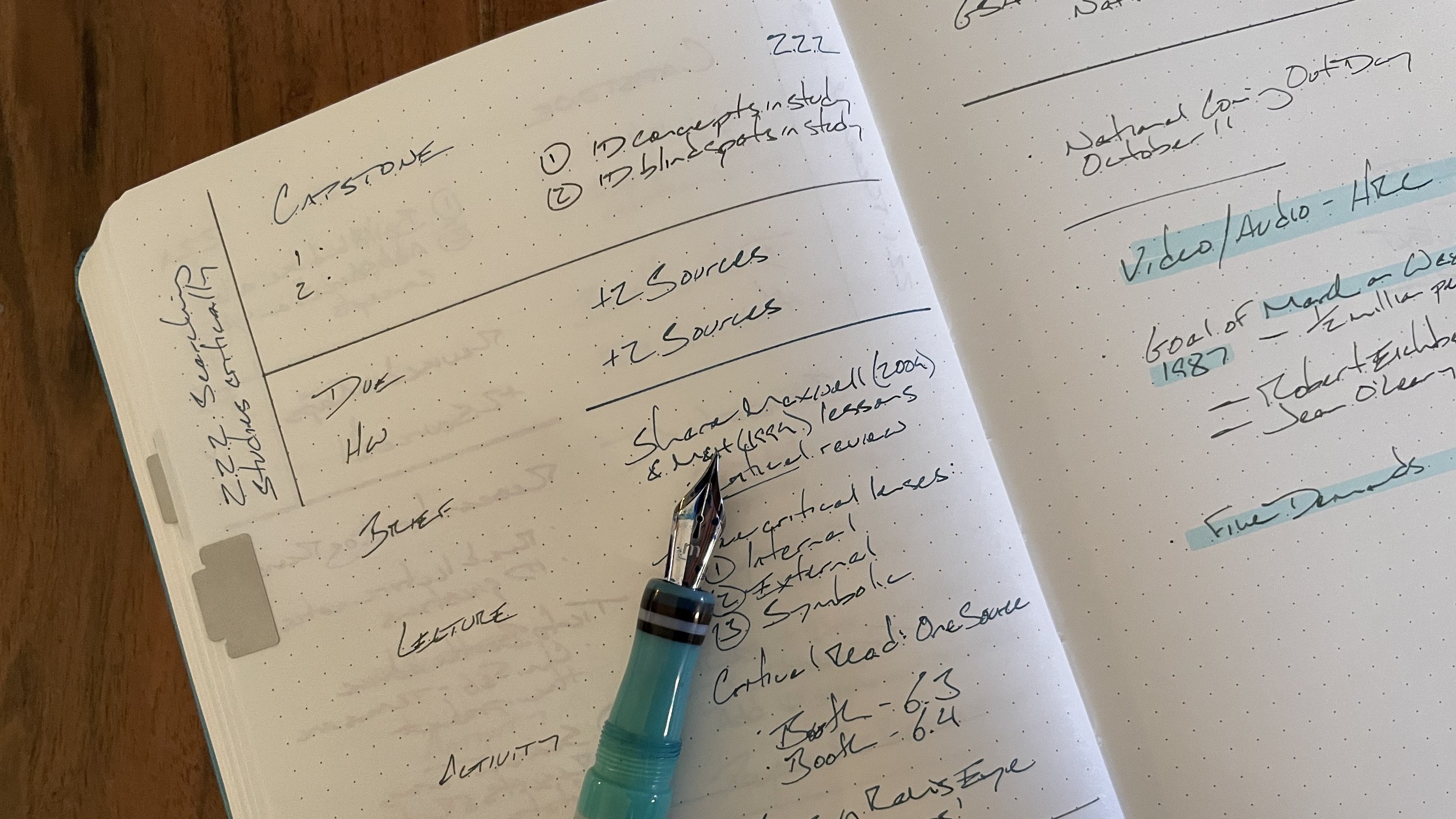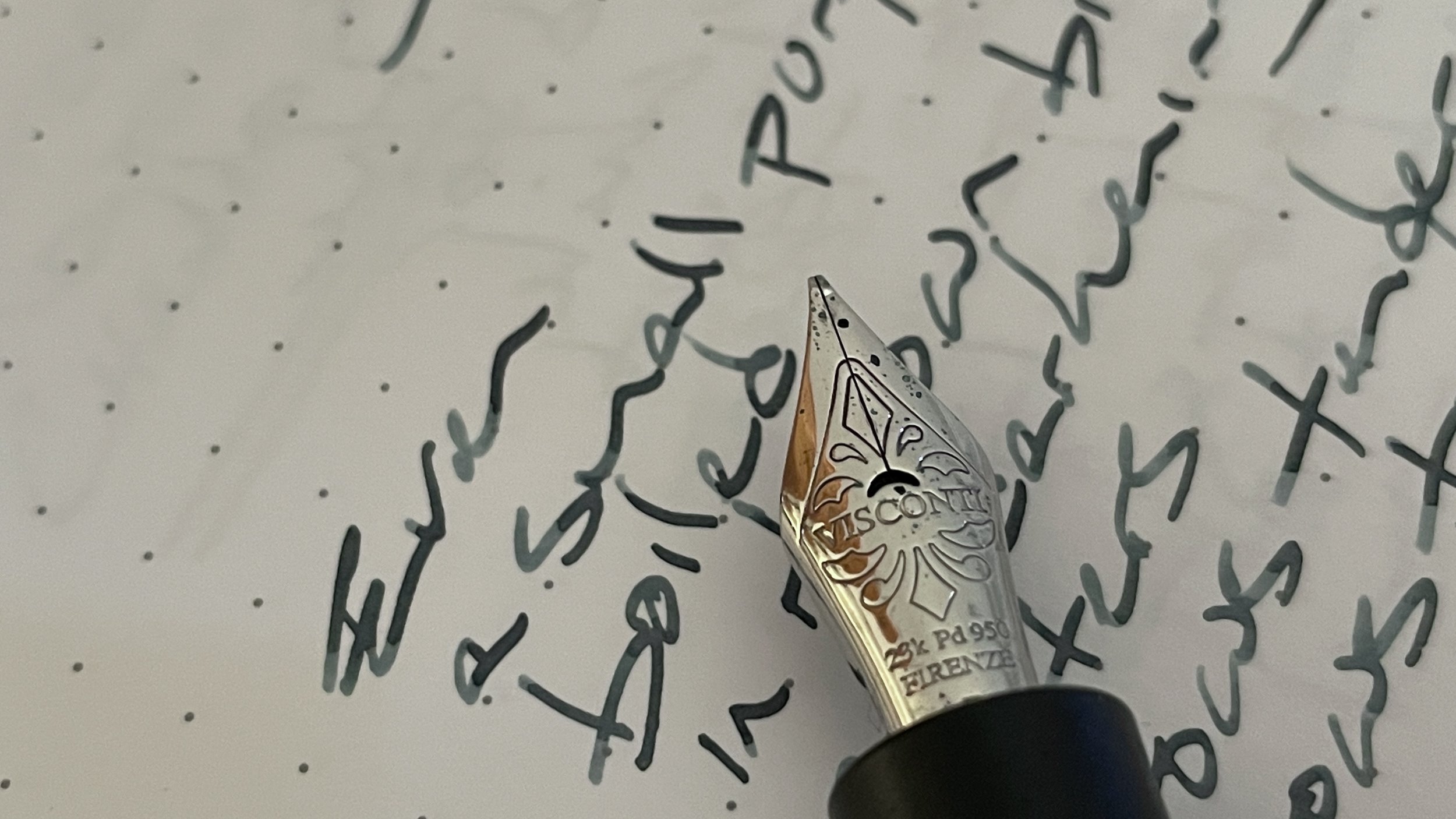2022 state of the scholar, the fourth and final tray
I review my pen collection every year or two. The goal is to ensure that all of the pens in my case remain interesting enough to me that they make me want to write.
I started this year’s review back in July and continued to review another tray each month since. I thought through tray two in August and tray three in September. This week is the fourth and final tray.
My collection reviewing process weighs each pen against my guiding principals. Those principles, taken from my description back in July, are that
“I hold the same rule for my collection as I do for technology (new apps and the like): each pen should work for me, not me for it. As the kinds of projects I take on change, the pens and inks that serve me best also change. Moving targets.
With respect to my writing, this means sifting each pen from my trays through three filters.
Do I regularly use the pen?
Does the pen spark joy when I ink it up?
Is it well-suited to the kinds of writing I most commonly take up?”
We have reached the end of my collection reflection. The fourth and final 13-pen tray. Populated with one-offs from small makers and small one-or-two-pen collections. Chaos. A tray I lovingly call the “Tray of Unreasoned Un-order.”
Monteverde Giant Sequoia in Brown. The Giant Sequoia is made of a hard, unforgiving acrylic. But the shape and girth of the pen’s section render it comfortable in my hands — even through intensive writing sessions. Hard, but lovable. Like a wookie.
Easily screwed-in Jowo nib units makes the Sequoia a versatile writer. All of my Jowo nibs are possibilities. Add a functional, reliable clip for safe pocket carry. Together, the Sequoia is a frankenpen for any occasion.
No surprise I turn to the Sequoia regularly. It was last in my rotation back in May 2022. An unquestioned keeper.
Monteverde Rodeo Drive Polaris. I have inked the Rodeo Drive every other month for over a year. A regular, if organically chosen, cycle.
However, the metal-on-metal threads leave a loose seal, even when tightly capped. As a result, the Rodeo Drive dries out quickly and is prone to hard starts while the feed rushes ink to the paper.
The lack of an air-tight seal also limits this pen to standard inks. Shimmer inks clog quickly as liquids evaporate leaving dams of glitter in the feed. And sheen-heavy inks — which are often dry — hard start like it’s their job.
But this pen was a gift from my partner. C went out of her way to track down a fountain pen while out of town early in our dating days. The sentimental value makes needing to frequently flood the Rodeo Drive’s feed a tolerable experience. Relationships, my grandfather told me, are work.
The heart whispers: keep.
Loft Highworth in Ocean Teal. The Highworth is another large pen. The long, hourglass section keeps the pen comfortable for both quick notes and longform handwriting. Functional.
Further, the screw-in nib section accommodates Jowo nibs — of which I have many. So the Highworth is adaptable in addition to functional.
The Highworth is has a regular presence in my currently inked rotation. It’s fun, works well for how I write, and is pretty. Keep.
Carolina Charlotte in Matte Dragon Scales. A bulky matte-finish pen design from the casa de primary manipulation. The Charlotte was an active member of my longform writing crew for a full two months after I added the pen to my collection. I enjoy a sophisticated resin in matte. And the Matte Dragon delivers.
My penchant for EF nibs and small writing leaves me in need of fun options for wide-lined longform writers. I like B lines for journaling, for example, as the B lines fill out each line with comparatively few words. So I get to update my journals more quickly. You know, cheating.
Keeper. No doubts.
Mythic Aeschylus in Black & Red. A now-retired design of Mythic Pens’ wonderful Aeschylus model. It’s classic. Retro-modern. And history-themed. What’s a history educator not to like?
The combination of a wide body and narrow section lends balance to the Aeschylus. This pen is wonderful for the medium and lengthy written reflections that adorn my teaching bullet journal and personal journal.
Great theme. Fun, classic execution. And functional. Keep me signed up.
ASA Brahmaputra in Black Ebonite. ASA is a company I was interested in trying for years. So I was eager to put in an offer when a used Brahmaputra model came available through the Pen Addict’s Slack. The largest pen I own. So large, in fact, that the ASA must sit diagonally across two pen slots to fit inside a tray. Bigly big.
The matte black ebonite is striated and subtle. The broad plastic section borders on uncomfortably-wide for my writing grip. It’s sturdy and caps securely. And the ebonite smells strongly of burnt rubber. The size and smell combine to rarify when I tag this writer into my rotation.
As such, this pen may move on to a new home. A new home with larger hands.
Nahvalur (aka. Narwhal) Schuylkill Chromis Teal. This pen grew into a fast favorite of mine once I stumbled onto the titanium EF Bock nib that now resides in my Schuylkill. A reliable, sturdy piston filler with a feed that offers M-width lines. Suitable for repeated medium-length writing sessions and short jottings.
The Chromis Teal material sits in a goldilocks between my penchant for pastels and my collection’s dearth of earth tones.
The Schuylkill is a regular in my weekly currently inked lineups. Certain keeper.
Jinhao 9035 Walnut. A wood-body pen with a rubberized grip. Simply a fun, earthy platform for whatever Jowo nib interest me. Fun composition and easy adaptability.
The Pilot-esque clip holds securely to paper and clothing. And the clip attaches with only one hand. Thus, the 9035 is also a hearty pocket carry.
An infrequent writing partner. But a keeper as it offers a rare spark of difference when I need it.
Conklin Mark Twain Crescent Filler in Black and Rose Gold. My father bequeathed the Mark Twain to me this past spring. The rose gold cap band had come unglued from the cap. I repaired the pen. My dad was worried about the pen breaking during a deposition and so gave it unto me for safe keeping.
A pen that is not mine. I prefer to think of the Conklin as a pen I hold in trust until my dad is ready to again crescent-up his deposition notes.
The questionables: KACO Green Retro in Blue, KACO Green Edge in Black, Majohn A1 Clipless in Matte Black and Wing Sung 601 in Battleship Grey. I’ve grouped these four pens together as they share a common characteristic. All four are arguably homages to well-respected pens from other brands.
I dip into these pens when hankering for novelty. The KACO and Wing Sung pens are excellent pocket carries. Their price points keep anxiety about possible EDC damage low. And all four simply work.
The relationship between price and quality is not linear. And these four all bring regular quality to my rotations. Keep x4.
Phew! All four trays are evaluated.
You can travel through my entire pen collection over at the pen database page. The page live-updates with which pens I’m using, which I’m ignoring, and which are traveling on loan with friends. The same can be said for my ink collection. Beep boop.
This week’s Inked Tines update includes last week’s currently inked writing tools.
Toolset
Pens. My sextet blurred together this week. Meaning: I enjoyed them all. No individual combo stood out. It happens.
Monteverde Rodeo Drive (1.1 mm) — Feed. Some hard starting after an evening sleeping in my penvelope. Wrote moderately wet once ink began to flow again. Easily stood out against the 146’s markings due to Koiame’s orange color and the broad 1.1 mm lines. A fun longform writer, as well.
Majohn A1 (EF) — Feed. My go-to in-class grading combination. The click mechanism empowered me to wander the room and jot notes on students’ work without fear of dropping and damaging a pen. The EF lines also played well with wild variances in students’ printer paper — so, marking papers as well.
Loft Highworth (EF) — 1/6. Another excellent pairing. The EF feed is wet enough to bring out Sabimidori’s blue notes. And rusty-green dry color proved different enough to separate writing from those made with the 146. Scratch notes, lesson planning, reading notes, and some journaling.
Sailor Pro Gear (Z Architect) — 1/5. My primary meeting notetaker. And my daily pocket carry. Having both thin EF lines and wide Z lines was perfect for quick-moving meetings (and teaching notes) that rarely afford opportunities to swap pens without falling behind. Also: journaling, lesson planning, and marking student papers.
Montblanc 146 (EF) — 1/2. A strong pairing. Sohayanotsuruki is lubricated enough to cover the square edges of Montblanc’s EF grind. This pair worked well for every kind of writing: task management, lesson plans, meeting notes, reading notes, and even scratch notes.
Visconti Homo Sapiens (F CI) — ?? Used sparingly. One session of reading notes led me to the conclusion that Petrichor is too close to Sohayanotsuruki to work for accent notetaking. Brainstorming, grade tracking, teaching reflections and lesson planning.
Notebooks. Work bujo. Odyssey Neptune 400 (A5). I scribbled another fifteen pages over the course of the week. A two-page weekly spread to manage my tasks, four pages of meeting notes, another two pages of lesson tracking, and seven pages of lesson plan outlines. A full house.
Every pen met paper during at least one meeting. However, the Sailor’s wet Z Architect nib returned to my meeting rotation three times between Monday and Friday. The only writer to three-peat.
Organization with a side of ink splatter
The Montblanc and Majohn made for clear, easily skimmed scratch notes. The EF lines suited the small letters I use for detailed notetaking. Precision printing.
An ethical form of logging?
I ended the week at page 114. Thank glob for Odyssey’s massive 400 page notebook. Ephemeral, process-writing takes up space.
Thinking space is space used beautifully
Journal. LIFE x Kleid Noble Note (B6). I filled the final five pages of this lovely LIFE journal by Wednesday evening. One reflection threw pages of short notes.
My journal concludes, as is my system, with a review of lessons and patterns I’ve learned since I started feeling into the LIFE notebook back on June 19.
Four lessons in full fall color
I also end personal journals with a list of the poems and lyrics and quotes that I often end entries with.
And herein I made a mistake. I alternated EF nibs to keep the list easily searchable: the Loft Highworth’s rusty-green Sabimidori and the Homo Sapiens’ multi-shaded Patrichor. Two colors that are too close to easily distinguish in a casual glance. Lesson learned.
Written dry. Both the Monteverde and Majohn made it down to their feeds by the weekend. Both continue laying ink on paper.
Rumors of our emptiness are greatly exaggerated
However, their ink levels are low enough that they will run empty soon. I prefer to swap out pens that have emptied their converters to prevent running dry during a meeting or class. How distracting.
Seeing the Majohn A1 written down to only the ink in its feed feels a feat. The EF nib is moderately wet. A lot of writing was needed to empty the pen. Clear evidence of how much I’m enjoying my newest acquisition.
The Monteverde sports both my widest nib and my brightest ink color. The Rodeo Drive proved an excellent accent notetaker.
Newly inked. Last week was a whirlwind. So while I wrote two pen-and-ink combinations down to their feeds, I marched forward without inking a seventh writer.
Discipline by distraction. Does that count? Let’s say that counts.
The collection
Incoming / new orders. My new journal arrived on Monday. A lovely A5 Endless Recorder in frigid grey and blue hues.
Cold as ice
I chose a notebook with paper I have yet to own: Endless’ own Regalia paper. They talk a big paper game. Endless promises absolutely no feathering. They also predict healthy showings of positive ink qualities: shading and sheen, for instance.
Lines so clean you can eat off ‘em
And my first entry on Saturday morning suggests Endless delivers on their promises. Regalia has quickly become one of my favorite papers.
Outgoing / trades or sales. I made progress with respect to the back-end work and pricing research that goes into offering up previously-cared-for pens.
Currently reading and listening
Fiction. The lull in my fiction reading continued on into this past week. Some reading is better than all of the reading.
Martin will need to spend another week held captive before (hopefully) escaping.
Nonfiction. I read two articles in preparation for my research methodology class. My TWA edition Blackwing and two Mildliner highlighters took the tour of both articles. I annotated to emphasize where my students can find great examples of researchers sharing background research.
Notes for future me
One is an excellent, well-structured study by O’Malley & Capper (2015) that employs both a traditional literature review in additional to what researchers call a conceptual framework.
The second is a similarly well-organized article by Meyer (2008) which employs a theoretical framework. Same reading tools, same topic, new variation on the topic. Content teacher.
The remainder of my non-fiction time was spent virtually hunting for primary sources within the Carlisle School’s online archives. Scratch notes in my teaching notebook are breadcrumbs to help me hone in on the best-suited sources for my students to explore later in the school year.
Music. An hour of jazz-inspired lo-fi songs is a tailor-made pomodoro-type productivity timer for writing and reading. I stop when the playlist ends.
I’m a fan of the artists Chillhop favors. And I dig their new grungy art style. Two positives in one video.

















